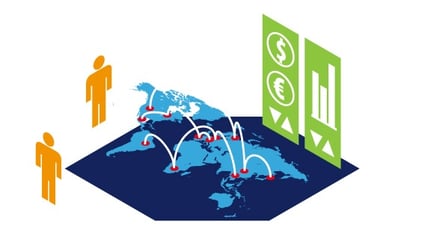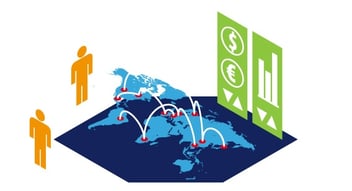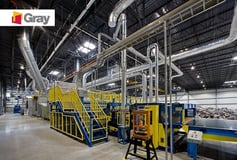Cloud vs. On-Premise: Which Is the Better Fit in Your Supply Chain?
Brian Hoey - March 12, 2020

 According to Gartner, by 2023 cloud-based supply chain technology will be worth $11B. And from the looks of it, that might not be far off. Optimism about the cloud is guiding decisions that companies are making with regard to their SCM and ERP technology—with investment in cloud infrastructure continuing to rise across industries. As with any new technology, though, it’s hard to separate the hype from the real value adds. Is the cloud the right choice for your value stream, or is good old fashioned on-premise hosting a safe bet?
According to Gartner, by 2023 cloud-based supply chain technology will be worth $11B. And from the looks of it, that might not be far off. Optimism about the cloud is guiding decisions that companies are making with regard to their SCM and ERP technology—with investment in cloud infrastructure continuing to rise across industries. As with any new technology, though, it’s hard to separate the hype from the real value adds. Is the cloud the right choice for your value stream, or is good old fashioned on-premise hosting a safe bet?
When it comes to this kind of decision, there’s no one-size-fits all answer—every supply chain is different, and you need to balance the pros and cons of the cloud against those needs when deciding whether or not to make the switch.
What Is Cloud-based Supply Chain Management?
Okay, first things first, what do we actually mean when we talk about cloud-based supply chain management? Simply put, this would mean pivoting away from hosting your software and/or storing your data in on-site, company-controlled servers, and instead housing that software and/or data in a remotely accessible third-party server. So far, one of the most common applications for this kind technology within the supply chain is cloud-based ERP solutions. In these types of deployments, manufacturers and other supply chain businesses centralize all of their data about product and stock volumes, customer orders, on-hand resources, etc. via one connected app stored via a third party. The hope here, generally speaking, is that this will improve the performance of the ERP software (in terms of processing speed, real-time data availability, and visibility, e.g.) while helping to improve ROI (through more predictable costs). But how exactly does it do those things, and how well would that mesh with your existing supply chain?
Cloud vs. On-Premise: Costs
Obviously, one of the first things that comes to mind with any kind of business transformation is cost. So how do the costs associated with cloud vs. on-prem supply chain management stack up?
- Hardware/maintenance costs: To maintain software and data on-premise, you’ll need to invest in servers and other equipment, and you’ll have to personally see to their maintenance, which may require hiring additional IT staff. For cloud-based applications, there are no such startup costs.
- Scaling costs: Most cloud offerings will offer pay-as-you-go options, meaning that you only pay for the storage that you actually need during any given period. This means that if you have a slow month, your cloud bill goes down, whereas a period in which you need to increase usage you can simply pay extra to do so. If your data and software are hosted on-premise, you may eventually need to add hardware if you reach your capacity limit, which can prove costly.
- Total cost of ownership: Because you pay as you go with cloud applications, there’s no point at which you “pay off” your investment per se. In this sense, it’s possible to achieve a lower total cost of ownership on on-premise servers (since you don’t have to keep paying for them after the initial investment). That said, most servers need to be upgraded every five years or so—to say nothing of other equipment breakdowns and replacements—so this isn’t necessarily cut and dried.
For a large manufacturer, the thought of laying out a lot of money on servers and beefing up the IT staff might just be a drop in the bucket, whereas a smaller agency might be more concerned with short term costs, which might make cloud services more attractive.
Speed, Accuracy, and Supply Chain Performance
Of course, at the end of the day it doesn’t really matter where the costs are being allocated if one technology has better outcomes—i.e. a better ROI—than the other. This is where things can get tricky; again, different supply chains have different needs, which might be best met by different technologies.
- Data velocity: For most companies, the cloud has a clear advantage when it comes to speeding up data flows. Because everything is connected and decentralized, you aren’t stuck waiting for different servers to exchange data—you simply ask for the information you want and it’s retrieved from wherever it is.
- Accuracy: The cloud’s comparative speed advantage does make it possible to approach real-time data integration in a way that can be difficult otherwise. This, in turn speeds up analytics workflows that require that data to make calculations. At the same time, because you have less control over the system, you’re arguably less likely to be able to resolve any IT-based accuracy issues that crop up.
- Security and Compliance: Historically, businesses have considered security a liability for cloud offerings, and to some extent that’s fair—since you don’t have physical control over access. At the same time, on-prem isn’t automatically more secure or more compliant. You need to pour your own resources into things like encryption, physical security, and other best practices on a consistent and ongoing basis in order to compete with the level of security that any reputable cloud provider will offer today.
If there’s one more major takeaway we’d like to impart here, it’s that cloud services will often invite more flexibility on the whole. For businesses that are seeking to go lean, or to become more proactive in their planning cycles, the cloud can be one way of achieving the data visibility and integration you’ll need in order to make that happen. Sure, if it ain’t broke don’t fix it: plenty of businesses have had, and will continue to have, real supply chain success hosting their ERP and other functionality in-house. At the same time, the modern global supply chain is changing rapidly, and moving away from in-house servers and other hardware that could quickly go out of date is one way to stay ahead of the curve and adapt more fluidly to new technological realities. After all, if you install a server and realize that it doesn’t have capabilities you need in order to power real-time data exchanges between your freight parters and your suppliers—you either live with the consequences or make another large investment. On the cloud, you might be out that month’s subscription, but you’re not stuck with a bunch of unwanted hardware and licenses.
LATEST POSTS
- Understand Circular Economy in The Manufacturing Industry
- How Can Industry 4.0 IT Integration Be Achieved Smoothly?
- The Significance of Order Sequencing in Discrete Manufacturing
- How to improve your Supply Chain Management: The Power of Control Towers
- Optimizing Human Resource Scheduling in Manufacturing: A Technological Approach



